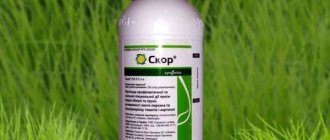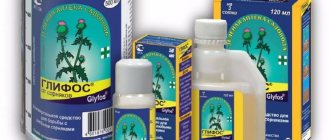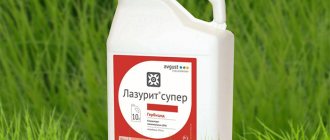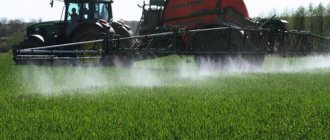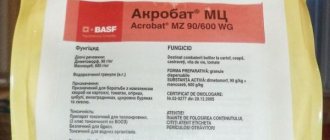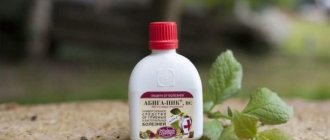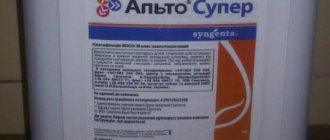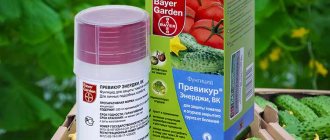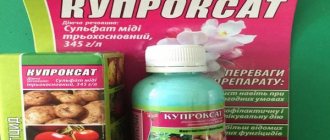Composition, release form and purpose of the drug Kolosal Pro
The product for combating fungal infections includes 2 active ingredients:
- propiconazole – 300 grams per liter, that is, 30%;
- tebuconazole – 200 grams per liter, 20%.
These substances belong to the group of triazoles - organic compounds that inhibit the synthesis of sterols in the body of fungi.
High fungicidal properties are ensured by the fine dispersion of the solution - Kolosal particles do not exceed 200 nanometers.
The fungicide is produced in plastic canisters of 5 and 10 liters. The developer and manufacturer of the drug is Avgust LLC, Russia.
Kolosal was created for the industrial treatment of agricultural crops over large areas against fungal infection. Areas of application:
- Cereals. Rust – brown, yellow, stem, dwarf. Spotting – dark brown, netted, striped. Powdery mildew.
- Grapes are oidium.
- Sugar beet – fomoz, cercospora, powdery mildew.
- Soybean – ascochyta blight, cercospora blight, alternaria blight, septoria blight, anthracnose.
- Rapeseed - phomosis, powdery mildew, alternaria.
- Peas - anthracnose, rust, powdery mildew, ascochyta blight.
The drug is defined as a nanoemulsion; the smallest particles are easily sprayed and distributed throughout the tissue structures of plants in a short time.
Purpose
The drug is intended for the treatment of crops against fungal diseases.
The principle of action of the drug is that its main components inhibit and stop the production of ergosterol in the cell membranes of fungi. With the death of pathogens, mycelial growth stops, and plant crops can be saved from wilting even with obvious symptoms of the disease.
Kolosal Pro has not only a therapeutic, but also a stimulating effect; propiconazole in its composition improves plant vegetation and accelerates photosynthesis. As a result, the productivity of vegetable and grain crops increases.
The beneficial effect after spraying can be observed 2-4 hours after application. The preventive and therapeutic effect of the drug lasts for 4-5 weeks, the fungicide is poorly washed off from the leaves by precipitation, and in heat and drought its protective properties only increase.
The particle size when spraying Colosal Pro does not exceed 200 nm, which ensures good penetration into tissue.
It is recommended to use Colosal Pro:
- For rust and powdery mildew of peas.
- For ascochyta blight, anthracnose and septoria blight of soybeans;
- Against rust and spot diseases of grain crops;
- Against fomoz, powdery mildew and cercospora of sugar beet;
- With grape oidium;
- Against Alternaria rape;
Available for sale as a liquid solution in canisters of 5 and 10 liters.
Note: The fungicide is most often used in the industrial processing of agricultural crops. It is quite inconvenient to use it in the garden.
Mechanism of action of the fungicide
The components of Kolosal Pro, which are in a state of fine suspension, rise up through the plant conduction system and are distributed throughout all tissues. Both active substances suppress and stop the synthesis of ergosterol in the membranes of fungal cells. The death of fungi leads to a stop in the growth of mycelium (mycelium as a whole).
Tebuconazole and propiconazole have different areas of activity. The combined action suppresses all types of pathogenic flora. For infected crops, Kolosal Pro serves as a medicine, freeing it from pathogenic flora that have penetrated inside.
Propiconazole also stimulates vegetation in crops, as it increases the rate of photosynthesis.
Advantages of the drug
- Kolosal Pro has a tremendous penetration rate into plant parts. At the same time, it easily decomposes and is excreted by vegetative parts, purposefully acting effectively on the ear.
- Due to its high systemic properties, the fungicide has an excellent therapeutic effect. But it is most effective in the initial stages of the disease.
- The consumption of the drug is only 300 liters per hectare of crops.
- Kolosal Pro has a positive effect on the growth and formation of plants. After treatments, the yield and quality of grain increases.
Period of protective action and speed of exposure
2-4 hours after spraying, Kolosal spreads throughout tissue structures and begins to work. It stops the growth of mycelium, kills fungi that have penetrated inside and are destroying the plant.
See also
Composition and instructions for use of the disinfectant Deposit, dosage of the drugRead
Activity against pathogenic flora persists for 4-5 weeks. Precipitation does not affect the effectiveness of Kolosal. As the temperature rises, the fungicidal properties increase.
AgroChemService
To goods for agricultural producers
tebuconazole (250 g/l)
Systemic fungicide for protecting crops of grain crops, rapeseed, rice and grapes from a complex of diseases
A healthy ear means a HUGE harvest!
Advantages:
- complete protection of cereal grain crops from major diseases of the leaf, stem and ear, rapeseed from Alternaria and Phomosis, rice from blast disease, grapes from oidium
- very wide spectrum of action
- not only a preventive, but also a therapeutic effect for diseases that have already begun
- excellent systemic properties, rapid penetration and distribution within the plant
- long period of protection - for 4 - 5 weeks
Purpose:
- systemic fungicide with preventive and therapeutic action to protect crops from a range of diseases.
Active substance:
- tebuconazole, 250 g/l.
Preparative form:
- emulsion concentrate.
Characteristics of the active substance:
- Tebuconazole belongs to the triazole class.
Range of action:
- Brown, stem and yellow rust, septoria, powdery mildew, yellow spot or pyrenophorosis of wheat; dwarf and stem rust, powdery mildew, rhynchosporium, striped, netted and dark brown spot of barley; brown and stem rust, rhynchosporium, olive mold, fusarium head blight of rye, as well as Alternaria and phomosis of rapeseed and rice blast, grape oidium.
Mechanism of action of the drug:
- exhibits preventive and therapeutic systemic effects. Colosal penetrates the plant through the assimilating parts and spreads evenly throughout the xylem. The fungicide inhibits the biosynthesis of ergosterol in the membranes of pathogen cells and disrupts the metabolic process.
Impact speed:
- the drug penetrates the plant within 2 - 4 hours after application.
Period of protective action:
- provides protection of grain crops from infection for 4 - 5 weeks from the date of treatment.
Phytotoxicity, crop tolerance:
- if the instructions for use are followed, it is not phytotoxic.
Possibility of resistance:
- no cases of resistance to the drug have been identified, but to prevent its possible occurrence, it is recommended to alternate its use with drugs of other chemical classes.
Features of the drug:
- the penetration rate and duration of systemic action of Kolosal are due to the high activity of tebuconazole. Within a few hours after applying the fungicide, an improvement in the phytosanitary condition of plants is noted. Possessing excellent rain resistance, Kolosal guarantees reliable protection even in the event of precipitation after use.
Restrictions:
- The use of the drug on private farms and in water protection zones of water bodies is prohibited.
Storage conditions:
- in warehouses specially designed for pesticides, in hermetically sealed, undamaged original packaging at a storage temperature of minus 10 to plus 40 ° C.
Best before date:
- 2 years from the date of manufacture of the drug (subject to storage conditions).
Package:
- 5 liter canisters.
Culture
| Disease | Consumption rate, l/ha | Method, processing time | |
| Spring wheat | Brown, stem, yellow rust | 0,5 | Spraying at crop development stage 37 (flag leaf) and (or) 51 (beginning of heading) |
| Septoria, powdery mildew | 0,75 — 1,0 | ||
| Winter wheat | Brown, stem, yellow rust | 0,5 | |
| Powdery mildew | 0,75 — 1,0 | ||
| Septoria, yellow spot or pyrenophorosis | 1,0 | ||
| Spring barley | Dwarf rust, stem rust, powdery mildew, rhynchosporium, stripe spot, dark brown spot | 0,75 — 1,0 | Spraying during the growing season at the development stage 32 - 49 (stage of two nodes - opening of the last leaf sheath) |
| Net spot | 1,0 | ||
| Winter barley | Dwarf rust, rhynchosporium blight, dark brown spot, powdery mildew | 0,75 — 1,0 | |
| Striped spot, net spot | 1,0 | ||
| Winter rye | Brown, stem rust | 0,5 — 0,75 | Spraying during the growing season at the development stage 30 - 37 (beginning of stem formation - flag leaf) |
| Rhynchosporiasis, olive mold | 0,75 — 1,0 | ||
| Fusarium head blight | 1,0 | Spraying during the growing season at the development stage 55 - 56 (earing - flowering) | |
| Spring and winter rape | Alternaria blight, fomoz | Spraying during the growing season | |
| Rice | Blast | 0,75 | Spraying during the growing season at the panicle stage |
| Grape | Oidium | 0,4 | Spraying during the growing season in phases: visible formation of inflorescence, late flowering, pea-sized berries, beginning of the appearance of firm green berries |
Frequency of treatments:
- on wheat and spring rape – 1, on winter rape – 2, on grapes – 4.
Preparation of working solution:
The working fluid is prepared immediately before using Kolosal. First, it is necessary to prepare a stock solution of the drug (concentration no higher than 25% of the drug). With stirring, add no more than 2.5 liters of Kolosal (1/2 canister) to 7.5 liters of water and mix thoroughly for 3 - 5 minutes until a homogeneous white liquid is obtained. When adding the drug to water, white flakes of a non-homogenized emulsion may form. This is not an indicator of poor quality of the drug, since after mixing they completely disperse in water, forming a stable emulsion. If cold water is used to prepare the mother liquor (temperature 5 - 6 °C), it is necessary to increase the stirring time to 10 minutes.
It is possible to prepare a mother solution of a lower concentration.
Then the sprayer tank is filled 2/3 with water, the mixer is turned on and the stock solution of the drug is added. The sprayer tank continues to be filled with water while simultaneously mixing the working fluid to achieve its homogeneity. Stirring continues while spraying the plants.
Compatibility:
- Kolosal is compatible with most pesticides. However, in each specific case, the drugs being mixed should be checked for compatibility.
Working fluid consumption:
- for grains - 300 l/ha, for rapeseed - 400 l/ha, for rice - 100 l/ha, for grapes - 1000 l/ha.
Waiting period:
- on grains - 30 days, on rapeseed and rice - 40 days, on grapes - 50 days.
Timeframes for people to leave for mechanized work:
- 3 days.
Hazard Class:
- Hazard class 2 (dangerous compound). Work with the drug should only be carried out by plant protection specialists or under their supervision, or by persons who have undergone special professional training. It is necessary to comply with the requirements and precautions in accordance with GOST 12.3.041-86 and SanPiN 1.2.1077-01.
It is prohibited to work with the drug without personal protective equipment for the respiratory system, vision and skin.
First aid for poisoning:
- If the drug gets into your eyes, immediately rinse them with plenty of running water for 15 minutes with your eyelids open and consult a doctor.
- If the drug gets on the skin, immediately rinse with a stream of water or remove the contamination with cotton wool or a piece of cloth (carefully, without rubbing), then wash the skin thoroughly with soap and water.
- if inhaled, remove the victim to fresh air, change contaminated clothing and call a doctor.
- if swallowed, rinse your mouth with water, drink several glasses of water with a suspension of activated carbon (1 gsorbent per 1 kg of body weight), induce vomiting by irritating the back of the throat. If necessary, repeat the procedure several times, then drink a glass of water with activated carbon (1 g per 1 kg of body weight) and take a saline laxative (20 g of magnesium sulfate per 1/2 glass of water).
In all cases of drug poisoning, after providing first aid, the victim must consult a doctor.
Information for the doctor:
- Treatment is symptomatic. There are no specific antidotes.
If necessary, consult the toxicology center: 129010, Moscow, Sukharevskaya Square, 3. Moscow Research Institute of Emergency Medicine named after. Sklifosovsky. Toxicological information and consultation center. Tel., fax: (495) 921-68-85 (24 hours a day).
Safety measures during operation, transportation and storage:
- when working, it is necessary to comply with the requirements and precautions in accordance with GOST 12.3.041-86 and SanPiN 1.2.1077-01 “Hygienic requirements for the storage, use and transportation of pesticides and agrochemicals”, Moscow, 2002.
Transportation of the drug is carried out only in the original packaging with the original label by all types of vehicles in accordance with the rules for the transportation of dangerous goods in force for this type of transport.
Transportation and storage of the drug together with food products and animal feed is strictly prohibited!
Methods for neutralization, disposal of containers and pesticide residues:
- neutralization and disposal of containers, drug residues and rinsing waters must be carried out in accordance with SanPiN 1.2.1077-01 (Moscow, 2002) and “Temporary instructions for the preparation and disposal of prohibited and unsuitable for use pesticides and containers for them” ( VNIIPIAgrokhim, Ryazan, 1989).
Contamination of water bodies for domestic and fishing purposes directly with the drug or used containers is not allowed. It is forbidden to pour the drug into the sewer, as well as into any bodies of water!
Recommendations for the protection of useful flora and fauna:
- the drug is stable in soil (class 2), non-toxic to soil organisms and practically non-toxic to birds.
The drug is low-hazard for bees (class 3). When using, general safety precautions should be observed:
- carry out processing of plants in the morning and evening hours, before sunset, it is permissible to carry out them during the day in cloudy, cool weather, when bees do not fly out of the hive;
- at a wind speed of no more than 4 - 5 m/s;
- border protection zone for bees - at least 2 - 3 km;
- limiting the flight of bees for at least 7 - 8 hours.
The use of pesticides requires compliance with the basic provisions of the “Instructions for the Prevention of Bee Poisoning by Pesticides” (Moscow, State Aviation Administration of the USSR, 1989), including preliminary notification of local apiary owners about the nature of the plant protection product planned to be used, and the specific timing and areas of its application.
Fisheries assessment:
- 3rd class of danger. When using, do not allow the drug to enter fishery waters.
To goods for agricultural producers
Positive and negative sides
The undoubted advantages of the drug include:
- activity against most known fungi;
- high penetrating ability into all plant tissues;
- speed of action and long-term activity of the drug;
- pronounced medicinal properties - eliminates fungi from completely affected crops;
- used in any weather conditions, the effect covers almost the entire growing season;
- does not have an inhibitory effect on soil microorganisms.
The negative aspects of the impact and use of Kolosal Pro are considered:
- does not stop the formation of spores in some types of fungi, which requires repeated treatments;
- the drug is difficult to neutralize, therefore it is not used in homestead conditions;
- highly toxic to bees, beneficial insects, fish;
- It does not eliminate some types of fungal infections, in particular fusarium and root rot.
The drug is not used to protect seedlings and seedlings. Cereals should be pollinated before they emerge into the tube, since it does not penetrate into the ears later.
Precautionary measures
Propiconazole and tebuconazole are substances of the 3rd class of danger for humans and warm-blooded animals (moderately hazardous substances). However, when developing precautionary measures for working with Kolosal, the following are taken into account. factors:
- For 1st generation triazoles, used since 1979, carcinogenic activity and long-term post-effects on the environment have been fairly reliably established;
- 2nd generation triazoles, based on long-term observations, are increasingly suspicious of the same thing;
- DV formations of CME/CNE easily penetrate the body through unprotected skin;
- Due to their stability, propiconazole and tebuconazole persist for a long time in the human body;
- The same active substances are highly dangerous for bees, beneficial insects and aquatic organisms;
- For the same reason, neutralization of residues is difficult.
Based on this, the security zones for working with the Kolosal fungicide are established as follows:
- Apiary – from 6.5 km. There are no restrictions on the flight of bees in nearby apiaries, because after using the drug, bees will be poisoned from them in the treated areas throughout the season;
- Reservoirs, water supply sources - according to their cadastral water protection zone, but not closer than 1.5 km during aerial processing;
- Children's, medical and recreational institutions - 500 m;
- Any residential buildings (including temporarily inhabited), food storage facilities, premises and areas for keeping pets - 150 m2;
- Other outbuildings and adjacent productive land areas - 50 m for manual/mechanized and 500 m for aerial processing.
Full PPE for manual work with Kolosal fungicide must be used, see figure:
- Protective overalls for the body.
- On the face - safety glasses and a filtering respirator. The anti-dust petal respirator is absolutely unsuitable.
- Wear rubber protective gloves for working with pesticides. The sleeves of the overalls are pulled over the cuffs of the gloves.
- On your feet - waterproof rubber boots. The overalls are worn with untucked trousers.
After work, PPE is treated with special neutralizing liquids based on organic solvents. The discharge of neutralizing compounds is collected in a moisture-proof, chemically inert container and delivered for disposal to a special receptacle. The operator who worked with Kolosal should immediately after work wash thoroughly in the shower with detergents based on saponin or synthetic surfactants (head shampoo, gel or body shampoo). It is better for specialists to handle PPE after working with Kolosal. profile, having the corresponding equipment, as well as neutralizing the spilled drug.
Note: it is best to involve on-call specialists for the entire treatment of crops/plantings with Kolosal. Considering that a canister of the drug is enough for 8-30 hectares of land, this will most likely cost less than doing it yourself.
Symptoms of Kolosal poisoning are mild: irritation of the eyes, mucous membranes, skin, indigestion, general weakness and malaise.
If any of them are detected during work, you should immediately stop, rinse and cleanse the stomach with home remedies and consult a toxicologist. If unusual illness occurs within 2-3 weeks after using the drug, you should also consult a doctor. The fungicide Kolosal is stored under the usual conditions for agrochemicals: in a separate non-residential premises, inaccessible to children and animals. You cannot store food products, medications, supplies or household items there. It is highly desirable that the floor in the storage of Kolosal and other agrochemicals in the form of an oil emulsion be moisture-resistant and moisture-proof, for example. covered with linoleum with a protective layer thickness of 0.4 mm. In this case, neutralization of the drug spilled on the floor can be done independently with a rag soaked in kerosene, solvent, etc. Used rags are burned in an incinerator.
Consumption rate for different plants
The manufacturer suggests using Kolosal in the following quantities:
| Culture | Liters of product per hectare | Working fluid volume (liters) | Waiting time (days) |
| Cereals | 0.3-0.4 | 300 | 38 |
| Grape | 0.2-0.3 | 800-1000 | 30 |
| Rape | 0.5-0.6 | 200-400 | 40 |
| Legumes | 0.4-0.6 | 200-400 | 40 |
| Sugar beet | 0.4-0.6 | 200-400 | 30 |
The upper permissible value of the amount of fungicide is chosen if the crops are heavily infected.
Instructions for use
When using the substance, you must strictly follow the instructions. The dosage and features of use of the composition are indicated in the table:
| Substance use rate | Culture | Diseases | Processing Features | Waiting period (number of treatments) |
| 0,5 | Spring wheat | Yellow, stem, brown rust | It is necessary to spray the plantings during the growing season. This should be done at the stage of flag leaf appearance - during the beginning of heading. 300 liters of working solution are required per 1 hectare. | 30 (1) |
| 0,75-1 | Spring wheat | Septoria, powdery mildew | It is necessary to spray the plantings at the stage when the flag leaf begins to grow. 300 liters of substance are needed per 1 hectare. | 30 (1) |
| 0,5 | Winter wheat | Yellow, brown, stem rust | It is necessary to spray the plantings at the stage of flag leaf growth. The consumption of the working solution is 300 liters per 1 hectare. | 30 (1) |
| 0,75-1 | Winter wheat | Powdery mildew | Plantings need to be sprayed at the stage when the flag leaf appears. Working fluid consumption is 300 liters per 1 hectare. | 30 (1) |
| 1 | Winter wheat | Yellow spot, septoria, pyrenophorosis | Plantings need to be sprayed at the stage when the flag leaf appears. 1 hectare will require 300 liters of working fluid. | 30 (1) |
Application procedure
According to the instructions, the earlier the crops are treated, the more effective the fungicide is applied - at the beginning of the spread of the fungus and on young growing crops. Rules of application:
- grains – 1 time during early growing season;
- grapes - 3-4 times, the first time - before flowering, the last time - when the grapes are the size of peas;
- sugar beets, legumes, rapeseed - 1-2 times.
See also
Instructions for use of Polaris seed protectant and consumption rateRead
Crops are treated before the fungi damage the internal structures of the plants, in order to prevent crop loss.
Feedback from agronomists about the fungicide
Marat Yusupovich, Tatarstan
Read also: How to plant an apple tree in the fall
Kolosal Pro was used for processing winter wheat. Really not afraid of rain. It turned out that I delayed processing and it was no longer possible to wait. I relied on the description of the drug. And I was not mistaken. An hour before the rain was enough for the liquid to be absorbed and not washed away with water. The protection is quite long-lasting. But with severe damage, the drug does not cope.
Marina Valentinovna, Krasnodar region
I did not find information in the instructions on using Kolosal Pro for processing grapes. But there is such information on the Internet. The neighbors had little left of it and had nowhere to put it. I tried to cultivate the vineyard. I liked the result. It is very little tedious and just one treatment is enough if you catch the fungus at the very beginning.
Safety rules for use
When working with fungicide, you must follow the prescribed safety rules:
- Pour into containers on special platforms (concrete, compacted earth). Distance from housing, premises for animals, pastures, water sources - 200-500 meters.
- When diluting the fungicide and spraying, use protective suits - overalls, boots, respirators, goggles, gloves.
- Upon completion of work, wash thoroughly.
- Remains of the fungicide solution are disposed of using special means.
Store canisters in isolated storage rooms, separate from things, equipment, and products.
Information: there is no antidote for Kolosal; in case of poisoning, the usual means are used - gastric lavage, taking adsorbents.
Is it compatible with other products?
All crop protection products are compatible and can be used together. Pesticides and herbicides are mixed in a container with water, and Kolosal is added last.
The fungicide is not combined with concentrated alkalis or acids. After preparing the solution, a control test for phytotoxicity is required before treatment.
Similar means
To protect and treat different types of crops, fungicides with one or more active ingredients are used:
- PropiChance Universal. Complete analogue containing active components in the same proportions. .
- Altazol. . Contains 2 active ingredients – propiconazole and cyproconazole. Used for grains, sugar beets.
- Forecast. Systemic fungicide with propiconazole as an active ingredient.
- Soligor. Used for grain crops. Contains 3 active ingredients. Systemic fungicide.
If the type of pathogen is determined, fields can be treated with a smaller-spectrum fungicide with one active component.
The use of Kolosal Pro is a reliable and proven way to protect plants and obtain a stable harvest. Knowing the rules and strictly following the instructions for using a fungicide reduces the risk of toxic effects on the land, crops and humans.

